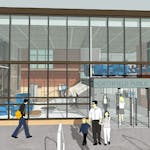Airplanes rumbling over Eagan, residents say, are interrupting their sleep, preventing them from enjoying their yards and causing coaches to halt their instructions as they wait for the jets to pass overhead.
Prompted by a group of fed-up citizens, the City Council last month sent a letter to the Federal Aviation Administration (FAA) that they hope will change flight paths and restore a bit of peace and quiet.
"There are times when the planes are coming every few minutes," said Steve Henry, an Eagan resident for 26 years. "It's really made our backyard oasis unusable in some cases."
Ted Gladhill, another Eagan resident, said he's seen 1,000 planes fly over his home in a month and 92 in a single day.
"We liken it to Pearl Harbor without the actual bombs dropping," he said.
Minneapolis-St. Paul International Airport, which sits just north of Eagan across the Minnesota River, in 2005 added Runway 17, sending planes over parts of the south metro.
It wasn't considered disruptive until 2015, according to several people who said it was then that they noticed a deafening uptick.
"Not only have I heard concerns from a lot of my constituents about the impact the noise has on their lives, all I have to do is sit on my back deck to experience it," said U.S. Rep. Angie Craig, an Eagan resident who added that the planes' roar often interrupts the videos she tapes for constituents. "Anyone who lives in Eagan will tell you that it's gotten worse."
Craig, who sits on the House Committee on Transportation and Infrastructure and its aviation subcommittee, said she supports the city's efforts. She hopes the FAA, which regulates air traffic, will consider the City Council's letter and the changes it proposes.
The difference in the number of planes overhead isn't imaginary, said Dianne Miller, Eagan's assistant city administrator. In 2015, the FAA debuted new safety standards designed to decrease the chances of collision when planes' flight patterns converge.
Since then, 34% of all planes leaving MSP have departed from Runway 17, compared with 25% before 2015, Miller said, citing a recent Metropolitan Airports Commission (MAC) study. Many fly over heavily residential areas in Eagan.
Miller said residents often tell her that they're frustrated by the din because they moved to Eagan before the new runway was built. City officials are "optimistic and hopeful" that things will improve, she said.
But the path to quieter skies has many steps, said Brad Juffer, community relations manager for the MAC, which operates the airport.
First, a city must register its concerns with a MAC advisory board called the Noise Oversight Committee, made up of industry and community representatives. From there, the matter goes to the MAC's planning, development and environment committee and then onto the MAC as a whole. Finally, it goes to the FAA.
Eagan's letter was discussed at the advisory board's September meeting, with action expected in November. If all hurdles are cleared, the FAA will get Eagan's letter in December.
Juffer said it's been a while since the MAC has undertaken the process. In the early 2000s, Mendota Heights successfully lobbied to have planes routed over less-residential areas.
The FAA wants airport operators to thoroughly vet ground concerns and share them with the wider community before making changes, he said.
"I think the main thing is, we're supportive of it if there's no negative impact to efficiency or safety," Juffer said. "We're hopeful that this one has a positive result."
Residents said that the city's letter, which outlines three separate issues with current flight patterns, proposes doable solutions that don't involve passing the problem to other communities.
One idea is to have some planes headed to the northeast U.S. to go back to using Runway 12R, which routes planes over less-residential areas. Runways 12R and 12L are supposed to be priority runways, but planes often use Runway 17 instead.
Other suggestions include directing planes taking off from Runway 17 to go over the Minnesota River corridor or Cedar Avenue rather than over homes, or requiring some planes leaving from Runway 12 to fly higher before turning.
"We think there are some solutions that seem to be reasonable and seem to be painless," Henry said.
If the issue had to do with any other kind of pollution, government officials would come down hard on whoever was causing it, Henry said. Noise pollution, he said, seems to present "a weird little double standard."
In addition to increasing stress, Gladhill said the clamor has led to medical issues. His wife came down with a bad ear infection from using earplugs every night to sleep, he said.
Residents now have "a glimmer of hope" thanks to the city's letter, Gladhill said, though he knows it could be years before anything changes.
The noise, he said, "was thrust upon us. We need the MAC and the FAA to be responsible and realize no one's asking them to sacrifice safety."
Erin Adler • 612-673-1781






